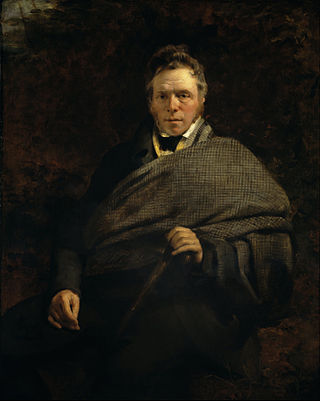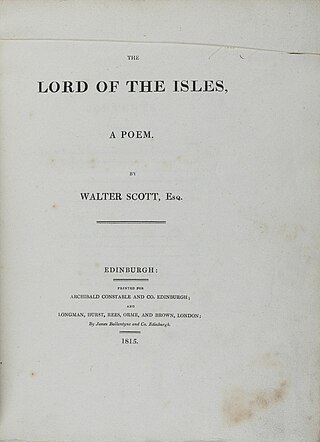Related Research Articles
The Spenserian stanza is a fixed verse form invented by Edmund Spenser for his epic poem The Faerie Queene (1590–96). Each stanza contains nine lines in total: eight lines in iambic pentameter followed by a single 'alexandrine' line in iambic hexameter. The rhyme scheme of these lines is ABABBCBCC.

James Hogg was a Scottish poet, novelist and essayist who wrote in both Scots and English. As a young man he worked as a shepherd and farmhand, and was largely self-educated through reading. He was a friend of many of the great writers of his day, including Sir Walter Scott, of whom he later wrote an unauthorised biography. He became widely known as the "Ettrick Shepherd", a nickname under which some of his works were published, and the character name he was given in the widely read series Noctes Ambrosianae, published in Blackwood's Magazine. He is best known today for his novel The Private Memoirs and Confessions of a Justified Sinner. His other works include the long poem The Queen's Wake (1813), his collection of songs Jacobite Relics (1819), and his two novels The Three Perils of Man (1822), and The Three Perils of Woman (1823).

The Lay of the Last Minstrel (1805) is a narrative poem in six cantos with copious antiquarian notes by Walter Scott. Set in the Scottish Borders in the mid-16th century, it is represented within the work as being sung by a minstrel late in the 1600s.
Alexander Bald was a Scottish poet.

The Vision of Don Roderick is a poem in Spenserian stanzas by Sir Walter Scott, published in 1811. It celebrated the recent victories of the Duke of Wellington during the Peninsular War, and proceeds of its sale were to raise funds for Portugal.

The Bridal of Triermain is a narrative poem in three cantos by Walter Scott, published anonymously in 1813. It is written in a flexible metre of four and three stress lines. Set in Cumberland, it recounts the exploits of a knight as he seeks to rescue a beautiful maiden, Gyneth, the illegitimate daughter of King Arthur, doomed by Merlin 500 years previously to an enchanted sleep inside a magic castle.

The Lord of the Isles is a narrative poem by Walter Scott in six cantos with substantial notes. Set in 1307 and 1314 Scotland it covers the story of Robert the Bruce from his return from exile in Ireland to the successful culmination of his struggle to secure Scottish independence from English control at the Battle of Bannockburn. Interwoven with this account is a romantic fiction centring on one of the Bruce's prominent supporters, Ronald, Lord of the Isles, involving his love for the Bruce's sister Isabel, who eventually takes the veil, and the transfer of his affections to Edith of Lorn to whom he had been betrothed at the beginning of the poem and whom he marries at the end.

Rokeby (1813) is a narrative poem in six cantos with voluminous antiquarian notes by Walter Scott. It is set in Teesdale during the English Civil War.
The Queen's Wake is a narrative poem by James Hogg, first published in 1813. It consists of an Introduction, three Nights, and a Conclusion, totalling over five thousand lines, and there are also authorial notes. The poem presents the contributions, in various metres, of a series of Scottish bards to a competition organised by Mary, Queen of Scots on her arrival in Scotland from France in 1561.
The Mountain Bard (1807), containing 21 poems, was James Hogg's first substantial poetical publication.
The Spy was a periodical directed at the Edinburgh market, edited by James Hogg, with himself as principal contributor, which appeared from 1 September 1810 to 24 August 1811. It combined features of two types of periodical established in the 18th century, the essay periodical and the miscellany. As an outsider, Hogg used his periodical to give a critical view of the dominant upper-class culture of Edinburgh, with Walter Scott and Francis Jeffrey as its leading lights, and to launch his career as a writer of fiction as well as poetry.
The Pilgrims of the Sun is a narrative poem by James Hogg, first published in December 1814, dated 1815. It consists of four cantos, totalling somewhat less than 2000 lines. In similar vein to 'Kilmeny' in The Queen's Wake (1813), it tells of a young woman's journey to an ideal world and her return to earth.
Winter Evening Tales is a collection by James Hogg of four novellas, a number of short stories and sketches, and three poems, published in two volumes in 1820. Eleven of the items are reprinted, with varying degrees of revision, from Hogg's periodical The Spy (1810‒11).
Queen Hynde (1825) is an epic poem in six cantos by James Hogg. Set in western Scotland in the sixth century, it tells the story of the defeat of an invading Norwegian army by forces loyal to Queen Hynde, advised by Columba, and of the winning of her hand by the legitimate claimant of the throne Eiden. It is mostly in octosyllabic couplets.
Songs, By the Ettrick Shepherd is a collection of 113 songs by James Hogg published in 1831. All except one of the songs had previously appeared in print, mostly either in Hogg's earlier publications or in a range of periodicals.
A Queer Book (1832) is a collections of 26 poems, mostly short narratives, by James Hogg, all but two of which had been previously published, more than half of them in Blackwood's Edinburgh Magazine.
Altrive Tales (1832) by James Hogg is the only volume to have been published of a projected twelve-volume set with that title bringing together his collected prose fiction. It consists of an updated autobiographical memoir, a new novella, and two reprinted short stories.
Tales of the Wars of Montrose is a set of six fictional narratives by James Hogg published in 1835. Each of them centres on the fortunes of an individual during the civil conflict of the 1640s in Scotland.
A Series of Lay Sermons is a set of eleven moral and religious discourses by James Hogg published in 1834.
Scottish Pastorals (1801), containing five poems and two songs, was the first book published by James Hogg.
References
- ↑ Gillian Hughes, James Hogg: A Life (Edinburgh, 2007), 119‒20.
- ↑ The Collected Letters of James Hogg: Volume 1 1800‒1819, ed. Gillian Hughes (Edinburgh, 2004), 176: Hogg to Eliza Izett, 11 February 1814.
- ↑ James Hogg, Midsummer Night Dreams and Related Poems, ed. Jill Rubenstein, Gillian Hughes, and Meiko O'Halloran (Edinburgh, 2008), xiv.
- ↑ James Hogg, Mador of the Moor, ed. James E. Barcus (Edinburgh, 2005), xiv.
- ↑ Ibid., Appendix I (87‒95).
- ↑ Ibid., xxi.
- ↑ For a full list and survey of the reviews see ibid., xl‒xli (note 9) and xv‒xviii.